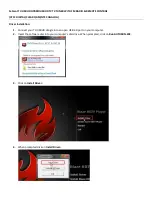
889-3809-02
Model 2018E Operations Manual Rev Apr 2020 Page
33
of 39
Timer input to become valid. When the AC line voltage is below 98V
RMS
, the indicator will flash at a 2 Hz rate to
indicate low line voltage. While the AC line voltage is low, all field status indicators will be off. Any active fault
indicators will stay on. See Section
for details on Monitor Power Up / Power Recovery. See Section
for details on Monitor Power Failure detection. See Section
for details on Low AC Power Thresholds.
4.2.3
VDC FAILED INDICATOR
The red
VDC FAILED
indicator is used to indicate that the voltage at the +24VDC input is outside of the
allowable operating range. The indicator will be on solid when the voltage on the +24VDC input is below 18V
DC
.
See Section
for more information.
When En24VDC Monitoring is enabled, this indicator will flash at a 5 Hz rate when the +24VDC input is
above 30V
DC
. The indicator will flash at a 1 Hz rate when the ripple on the +24VDC input exceeds 1V
RMS
. See
Section
for more information on +24VDC enhanced monitoring.
4.2.4
WDT ERROR INDICATOR
The red
WDT ERROR
indicator is used to indicate that a Watchdog fault has been detected on the Watchdog
Timer input. See Section
for more information on a Watchdog fault.
4.2.5
CONFLICT INDICATOR
The red
CONFLICT
indicator is used to indicate that a Conflict fault has been detected on the field inputs. See
Section
for more information on a Conflict fault.
4.2.6
RED FAIL INDICATOR
The red
RED FAIL
indicator is used to indicate that one or more channels of the monitor had no active field inputs
(Red, Yellow, or Green). See Section
for more information on a Red Fail fault.
4.2.7
MULTI IND INDICATOR
The red
MULT IND
indicator is used to indicate that one or more channels of the monitor had more than one
active field input (Red, Yellow, or Green). See Section
for more information on a Dual Indication fault.
4.2.8
YELLOW INDICATOR
The red
YELLOW
indicator is used to indicate that a Short Yellow or Short Clearance fault has been detected on
for more information on a Short Yellow fault and Section
information on a Short Clearance fault.
4.2.9
PC AJAR INDICATOR
The monitor has a red LED labeled
PC AJAR
that is used to indicate that the Program Card is not installed, not
seated properly, or that the inserted Program Card is not allowed. The latter can occur when the monitor is
configured to not allow a specific type of Program Card and that type of card is inserted in to the monitor. See
Section
for more information on a Program Card Absent fault.
See Section
for more information on
Do Not Allow 16 Channel Program Card and Section
for more information on Do Not Allow 18 Channel
Program Card.
The
PC AJAR
indicator can also indicate a configuration setting has changed by flashing at a 1 Hz rate. No
configuration changes are implemented until the front panel Reset switch is activated and held for five seconds. At
that time, you will hear five short beeps, the new settings will be implemented, and a Configuration Change log
entry made. See Section
for more information on configuration monitoring.
4.2.10
DIAG FAIL INDICATOR
The red
DIAG
FAIL
indicator is used to indicate that a Diagnostic fault has been detected. See Section
for
more information on Diagnostic codes.
This indicator is also used to alert the user to changes in the monitor code (firmware) that are presently under way
or have been made and have yet to be implemented. The LED will flash at a 5 Hz rate to indicate that the monitor
is currently receiving updated code. Once the updated code has been transferred, the 5 Hz flash rate will cease.
The LED will flash at a 1 Hz rate to indicate a pending code change (i.e. new code has been downloaded but not
implemented). Once power to the monitor has been cycled off and on, the code change will be implemented and
the 1 Hz flash rate will cease.
4.2.11
COMM INDICATOR
The
COMM
indicator turns on for 50 milliseconds every time a byte of data is transmitted or received by the
monitor. See Section
for more information on the serial communications port.







































